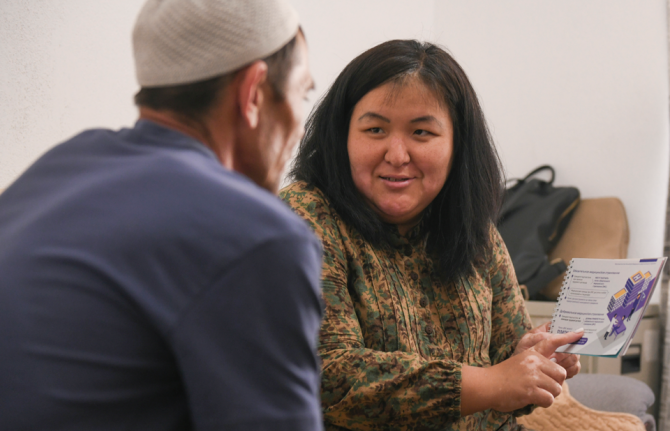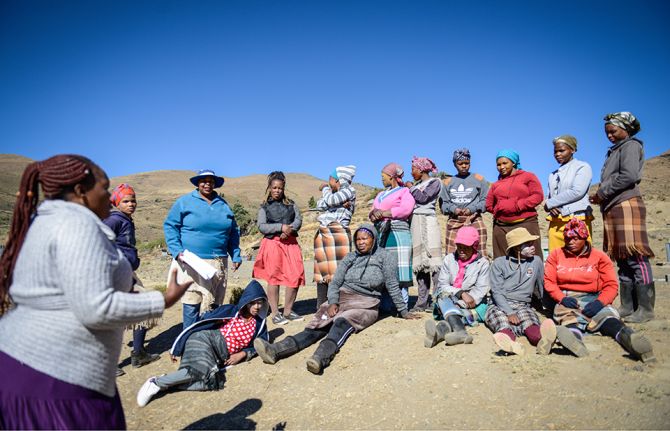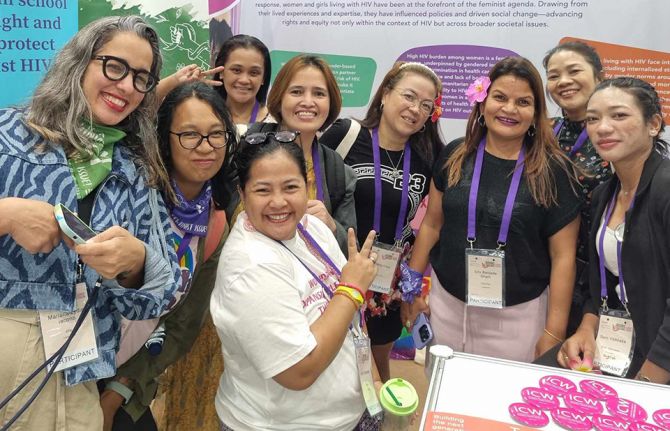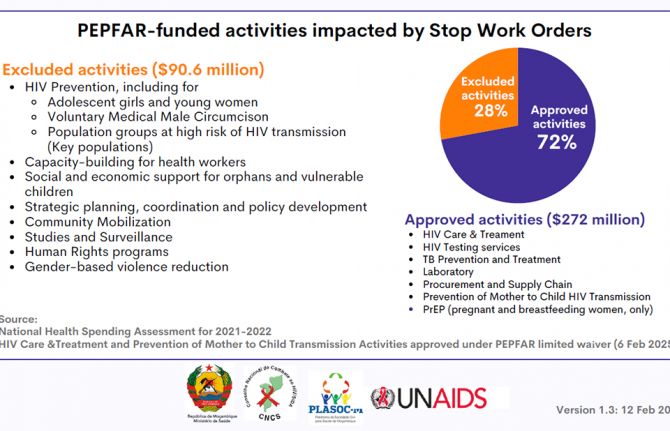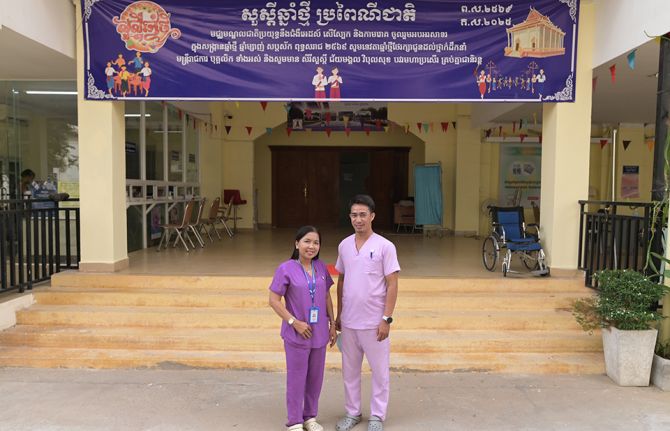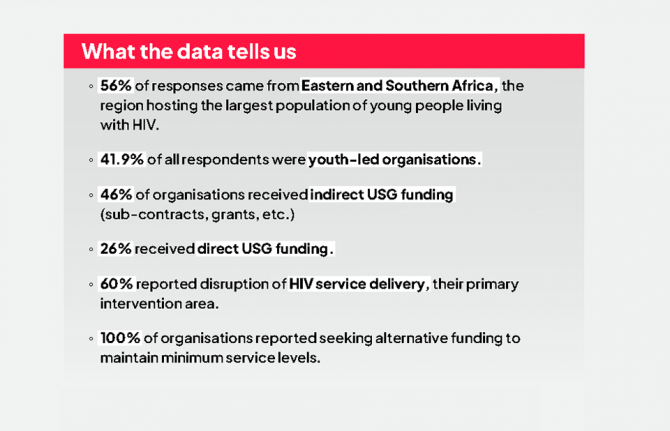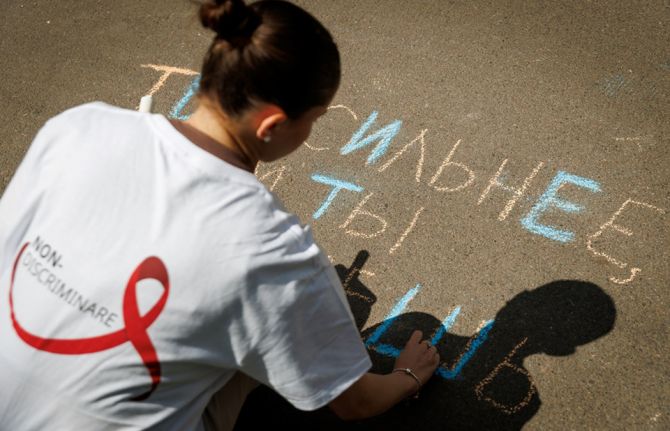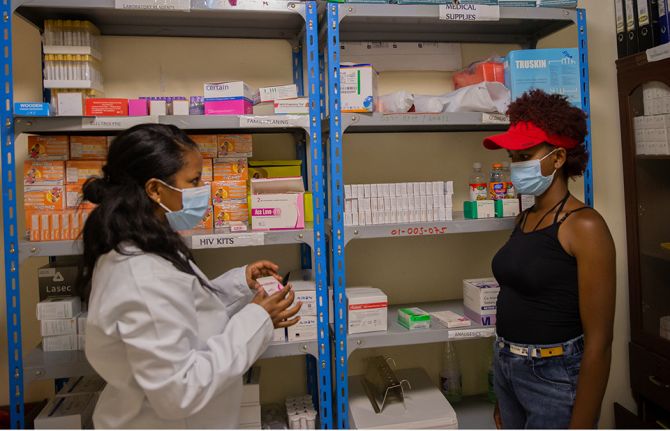


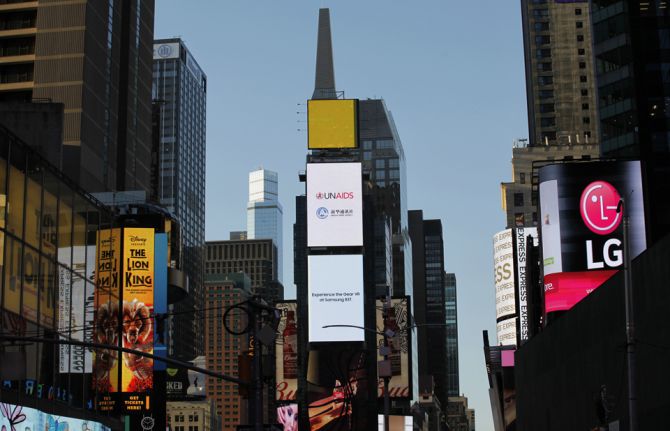
Update
UNAIDS video message goes live on Times Square billboard courtesy of Xinhua
08 June 2016
08 June 2016 08 June 2016For three days, a UNAIDS video is being played on a giant screen in Times Square, New York, United States of America.
Coinciding with the United Nations General Assembly High-Level Meeting on Ending AIDS, being held from 8 to 10 June in New York, the billboard screening will put an AIDS message at the forefront of people’s minds in one of the busiest crossroads of the world.
The 30-second clip highlights the importance of taking a Fast-Track approach to ending the AIDS epidemic, with the tag line, “Together we can reach an AIDS-free generation.”
The billboard screening is part of a partnership for the AIDS response between the Chinese news agency Xinhua and UNAIDS that was first signed in September 2011.
The year’s screening follows on from a video message from UNAIDS, supported by Xinhua, being played on a Times Square billboard during the 2011 High-Level Meeting on HIV and AIDS. Other efforts carried out during the past years under the Xinhua–UNAIDS memorandum of understanding include global media campaigns to promote public awareness of HIV and support for World AIDS Day activities. In addition, Xinhua will work with UNAIDS to publish and distribute a children’s book on living with HIV in China.
Xinhua is the world’s largest news agency, with more than 170 offices overseas and 31 domestic bureaus.
Quotes
"Hundreds of thousands of people walk through Times Square every day. Young, old, visitors or born and bred New Yorkers, we want everyone to know that ending AIDS by 2030 is possible. Thanks to Xinhua, this message is at the forefront of people’s minds.”
"Ending AIDS requires global solidarity. On the occasion of the High-Level Meeting on Ending AIDS, I would like to reiterate that as a responsible media organization, Xinhua is committed to supporting UNAIDS and other United Nations organizations in their efforts to improve the well-being of humanity.”
Related
Documents
High-Level Meeting on Ending AIDS
United Nations Member States have committed to implementing a bold agenda to end the AIDS epidemic by 2030 during the United Nations General Assembly High-Level Meeting on Ending AIDS, held in New York, United States of America, from 8 to 10 June.
Related
ICASA 2017
06 December 2017
72nd UN General Assembly, 19-25 September 2017
22 September 2017
Benin
03 March 2017
71st United Nations General Assembly
23 September 2016
High-Level Meeting on Ending AIDS
16 June 2016
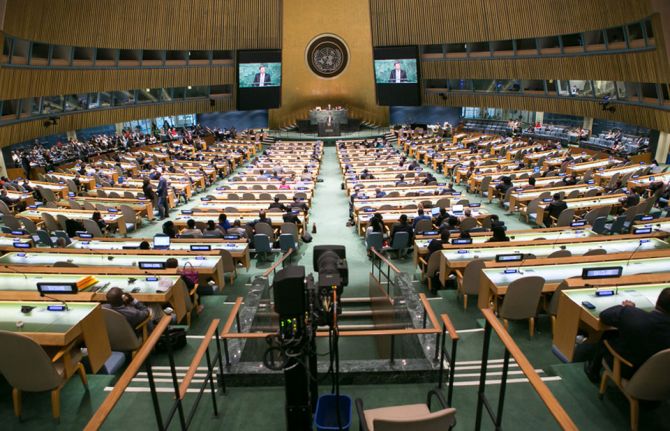 Bold commitments to action made at the United Nations General Assembly High-Level Meeting on Ending AIDS
Bold commitments to action made at the United Nations General Assembly High-Level Meeting on Ending AIDS

10 June 2016

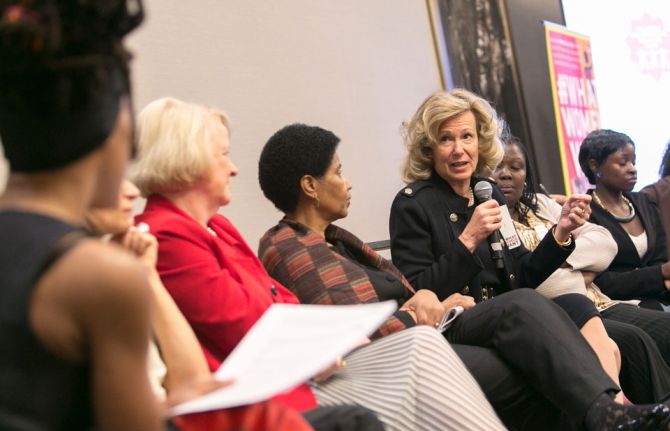
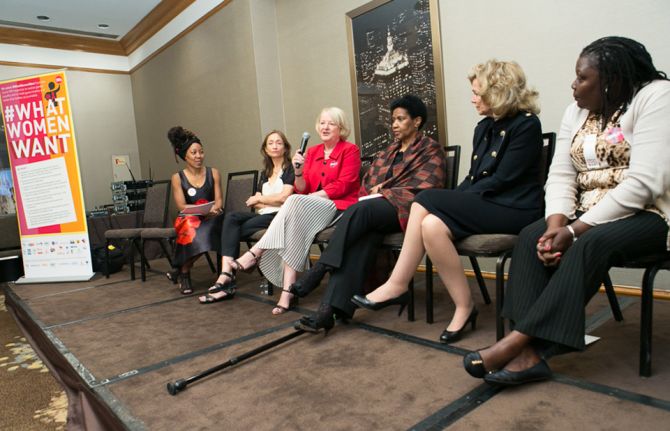
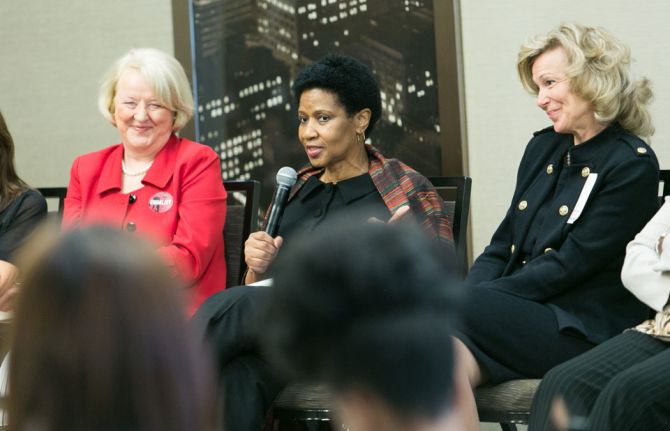
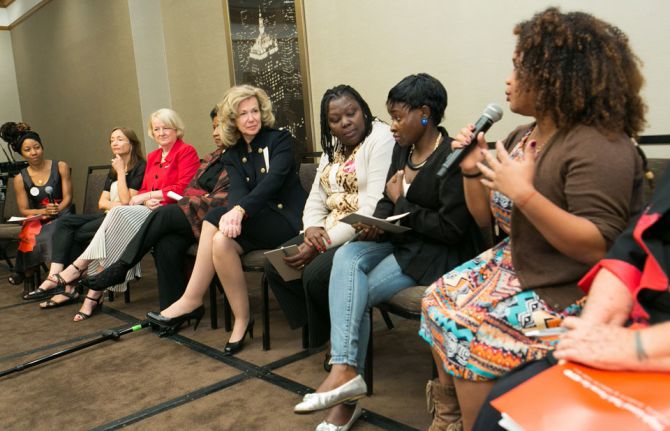
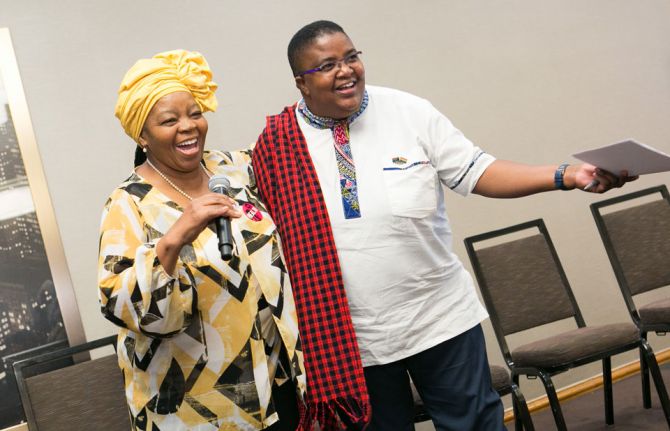
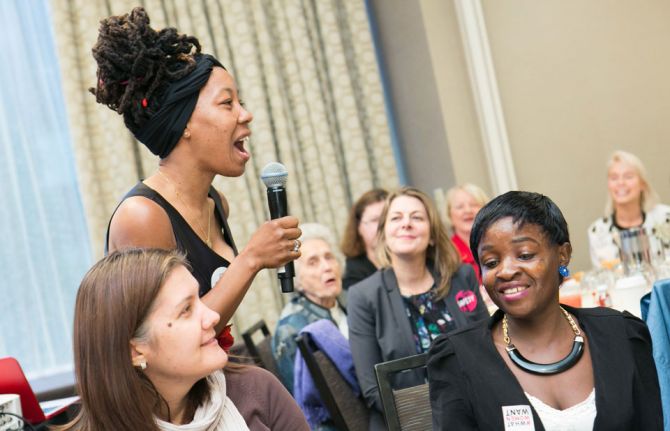
Update
Global HIV advocates gather to discuss #whatwomenwant in the next phase of the response to HIV
10 June 2016
10 June 2016 10 June 2016On 10 June, the last day of the United Nations General Assembly High-Level Meeting on Ending AIDS, held from 8 to 10 June in New York, United States of America, representatives of United Nations and women-led civil society organizations, young women and government leaders and women living with and affected by HIV, came together to inspire and move forward the role of women in the response to AIDS.
The breakfast event, entitled “#whatwomenwant”, was supported by UNAIDS and other partners and led by the ATHENA Network which represents 60 civil society partners from 25 countries dedicated to advancing gender equity and human rights in the global AIDS response.
The event was the culmination of a week of advocacy activities organised in the lead-up to the High-Level Meeting on Ending AIDS. Athena hosted a large-scale, coordinated Twitter campaign called #WhatWomenWant and led a global consultation to hear what women want and identify the specific key actions needed to leverage a sea change in the AIDS response for women and girls.
Young leaders from Africa, the Caribbean, Latin America, and Eastern Europe called for building bridges across movements, sectors and leaders. They emphasised the interconnectedness between HIV and broader women’s issues, such as child marriage and gender-based violence. They also called for meaningful places at decision-making tables and women-centered and women-led research and innovation.
In a lively session, participants shared personal views on the progress made to date and their views on what it would take to empower women and reach the goals of the 2016 Political Declaration on Ending AIDS by 2030. They explored options for stronger coordination and joint leadership to support women-led organizations and strengthen young women’s leadership in the HIV movement and beyond.
The Political Declaration strongly recognizes the importance of advancing gender equality and women’s empowerment as a human right and as critical to ending AIDS. This global political commitment is an unprecedented opportunity to focus on the specific vulnerabilities of young women and girls in all regions and to bring affected women to the centre of the agenda.
The new UNAIDS Strategy (2016-2020) is another example where commitments to gender transformative responses for human rights and gender equality have been centrally positioned. In order to meet the UNAIDS targets and the demands of what women want, sustained advocacy and accountability are essential.
The event concluded by calling for commitments to invest in young women’s leadership in order to bring sustainable change to the response to HIV.
Quotes
“The new Political Declaration on HIV and AIDS includes a significant focus on women and girls and acknowledges the interconnectedness of HIV with gender inequality, the empowerment of women, sexual and reproductive health and rights and gender-based violence. We need to invest in women and girls, especially adolescents, and give them space to have a voice globally, nationally and in the community and the family.”
“When a woman is criticized for not asking permission and for being vocal, we have to call it out every time. We need to stand up for each other. The United States Government is working hard to reach women and girls in new ways. Are we there yet? Not even close. But we are absolutely committed to getting the whole way there.”
“We need to expand the network of people who care and do. We need to work with men to talk about what masculinity is all about and how to live it. All of these things require risks. And if you don’t take risks, you don’t break ground.”
Women want love, hope, mental health, protection and to speak out and not be afraid and not have to ask permission. We are starting a revolution”
“When we talk about our stories, we are talking about where we have been and where we want to go. We must use every situation that comes our way to guide our girls to have them take up, come up and be who they want to be.”




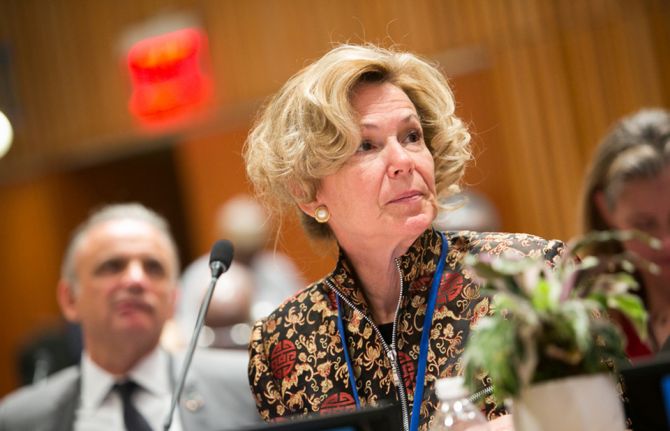
Update
Getting ahead of the looming treatment crisis: an action agenda for reaching 90–90–90
09 June 2016
09 June 2016 09 June 2016The key question of how the impending crisis in HIV treatment should be addressed dominated a panel meeting entitled “Getting ahead of the looming treatment crisis: an action agenda for reaching 90–90–90,” which met on 9 June at the United Nations General Assembly High-Level Meeting on Ending AIDS, being held from 8 to 10 June in New York, United States of America.
The panel discussion focused on the imperative of achieving the global 90–90–90 treatment target, whereby 90% of people living with HIV know their status, 90% of people who know their HIV-positive status are accessing treatment and 90% of people on treatment have a suppressed viral load.
Although such targets are realistic and achievable, the panel members argued that there is still a long way to go. Despite tremendous gains in treatment coverage, the current level is not sufficient to prevent the epidemic from rebounding in many countries.
A number of issues were cited, including the fact that half of all people living with HIV are unaware of their status and therefore not on treatment; given this figure, the number of people accessing antiretroviral therapy is expected to approximately double over the next five years. The sustainability of the supply of affordable antiretroviral medicines is uncertain, with new, more expensive, second- and third-line regimens becoming increasingly necessary. In addition, the generic market is concentrated among too few producers, which may have implications for sustainability.
The panel members suggested a range of recommendations to avert the looming treatment crisis. They stressed that the next phase of the AIDS response had to recognize new realities, such as rising migration and conflict, competing health and development issues and changing donor priorities.
Front-loading AIDS funding over the next five years was also advocated, with resources needed for ending the epidemic peaking at US$ 26.2 billion in 2020. Treatment must become more widely available and countries should support the development, production and delivery of high-quality medicines, using the Agreement on Trade-Related Aspects of Intellectual Property Rights (TRIPS Agreement) to create generics. Treatment delivery also needs to be broadened, with greater decentralization (such as community-based service delivery) and better access to viral load monitoring, the panel noted.
The need for low- and middle-income countries to increase their domestic funding was also raised, along with the role of the international community in lending its support where necessary to reach the 90–90–90 treatment target as a sound investment for global health and sustainable development.
During her remarks in the panel session, the United States Global AIDS Ambassador, Deborah Birx, announced a new US$ 100 million investment fund for key populations. Noting that although the 90–90–90 treatment target applies to everyone, to ensure access to all, the United States of America, through the President's Emergency Plan for AIDS Relief, would be taking action to ensure 90–90–90 for key populations. The new fund will support innovative, tailored, key population-led approaches to expand access to proven HIV prevention and treatment services so that the words “no one left behind” are translated into emergency action today.
Quotes
“I think we are all in agreement that the world is at an important turning point in the AIDS response. The current level of HIV treatment coverage is cup half-full and not sufficient to prevent the large number of AIDS-related deaths and to prevent the epidemic from rebounding in many countries. There must be a further massive scale-up in the provision of antiretroviral therapy, and this scale-up needs to happen as fast as possible.”
“Countries need to fully leverage their negotiating potential, including for pooled procurement, voluntary licensing mechanisms and/or other TRIPS Agreement (Agreement on Trade-Related Aspects of Intellectual Property Rights) flexibilities. Countries will have an increasing number of people on lifelong treatment. They need to intensify their efforts to rethink, scale and smarten the delivery of antiretroviral therapy.”
“Our government is committed that generic medicines for HIV will be available to all those who need it. India shall remain committed to the Doha Declaration on the TRIPS Agreement (Agreement on Trade-Related Aspects of Intellectual Property Rights) and Public Health. I don’t think there could be a clearer declaration of our policy.”
“Not all the news is good. In our region, most bilaterals have stopped financing. If this continues, it will become a true catastrophe. Without help, not only we will not be able to achieve 90–90–90, but those on HIV treatment will be taking obsolete medications. The Middle East and North Africa needs solidarity and needs it more than any region in the world.”
Related


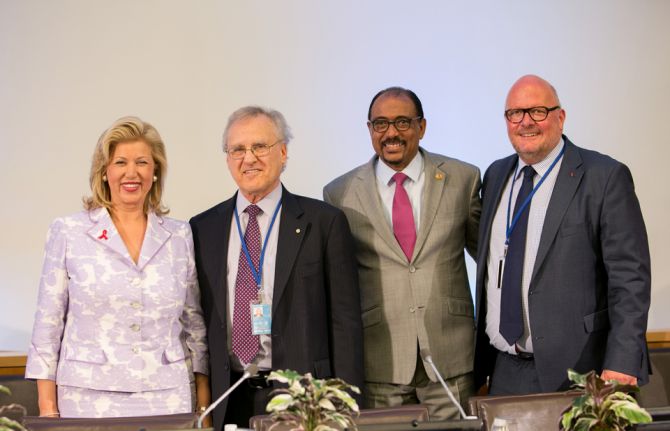
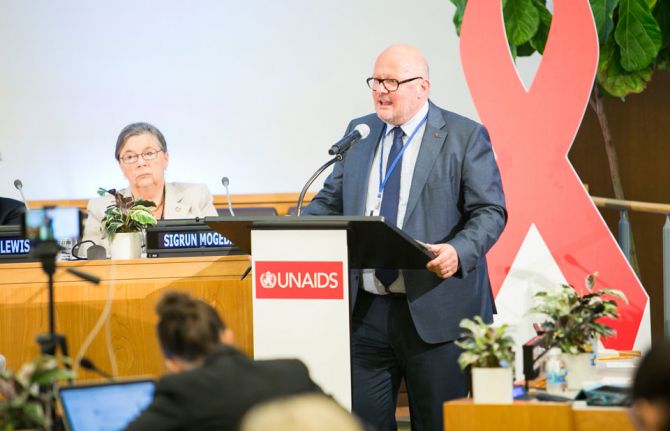
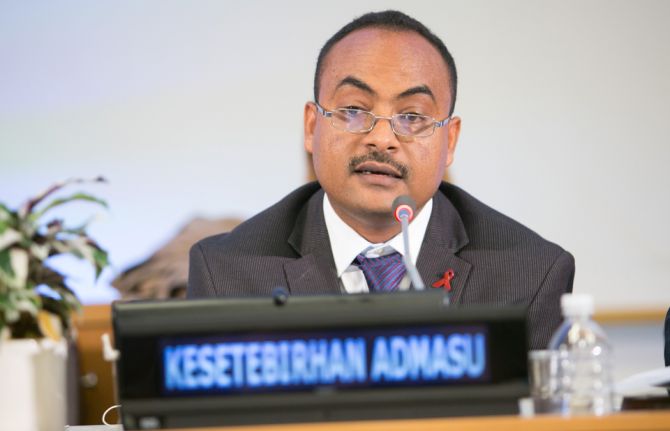
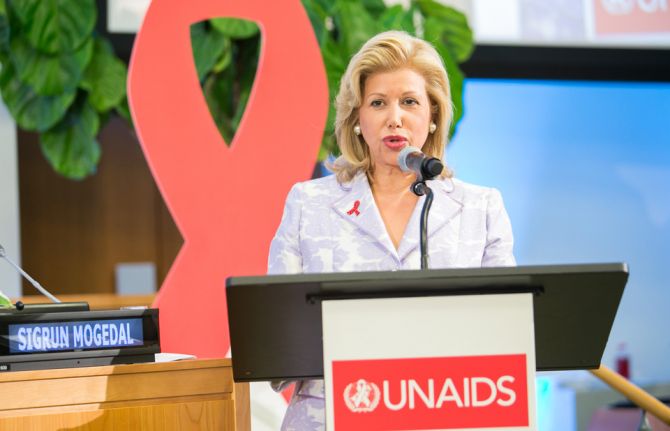
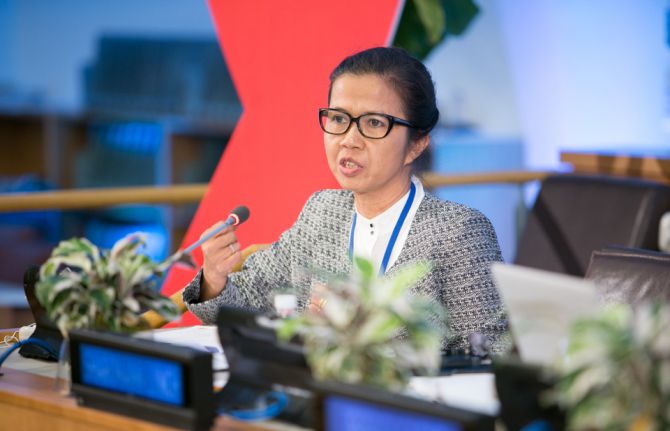
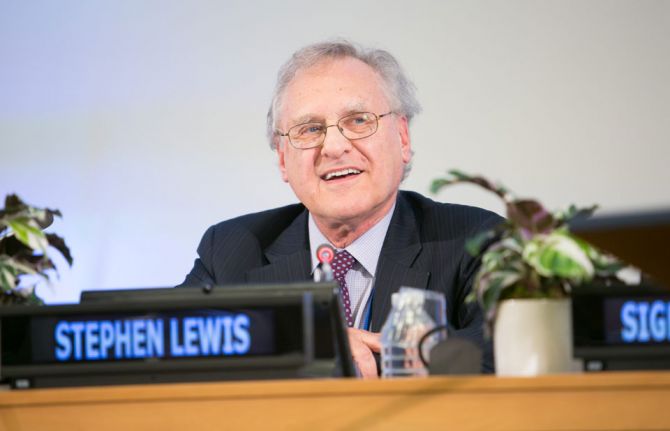
Update
Urgent need to strengthen community health systems to achieve the 90–90–90 treatment target
10 June 2016
10 June 2016 10 June 2016The 90–90–90 treatment target cannot be reached without a substantially greater involvement of a well-resourced and well-trained community health workforce, experts told a side event at the United Nations General Assembly High-Level Meeting on Ending AIDS, taking place in New York, United States of America, from 8 to 10 June.
Speakers at the side event, held on 9 June and entitled “90–90–90 and human resources for health,” emphasized that the 90–90–90 treatment target offers a road map towards the ultimate goal of ending the AIDS epidemic by 2030. However, shortages in human resources for health pose a grave threat to hopes for ending the epidemic as a public health threat.
Community health workers represent a potentially transformative mechanism for closing health workforce gaps and accelerating progress in scaling up HIV treatment and improving treatment outcomes. Kesetebirhan Admasu, Minister of Health of Ethiopia, described how the country’s health extension worker programme has substantially improved health-care access and helped make health services more sensitive to the needs of communities.
Community health systems are especially critical for ensuring access to essential health services among people who face challenges in accessing mainstream services, including members of key populations. Surang Janyam, of the Service Workers In Group in Thailand, explained how trained community health workers have expanded access to HIV services among sex workers, men who have sex with men and transgender people in Thailand and increased community ownership of the AIDS response.
Sigrun Mogedal, of the Global Health Workforce Alliance, said that the AIDS response should partner and coordinate closely with the many efforts already being undertaken to strengthen the health workforce. In 2016, the World Health Assembly approved a new global strategy for the health workforce, prioritizing the strengthening of community health systems. The Earth Institute of Columbia University is spearheading a global partnership to mobilize 1 million community health workers in Africa, and countries such as Ghana have taken important steps to train and deploy new cadres of community health workers.
However, the lack of growth in international HIV assistance potentially jeopardizes the world’s capacity to build a strong and durable health workforce to achieve the 90–90–90 treatment target, speakers in the session emphasized. Jeffrey Sachs, Director of the Earth Institute, and Stephen Lewis, Co-Founder of AIDS-Free World, called for urgent action to mobilize new resources for AIDS and to ensure that sufficient new funding is channelled to community systems.
Quotes
“We need to generate broad global commitment and action to ensure sufficient human resources to achieve 90–90–90.”
By moving from service client to service provider, communities can provide testing, antiretroviral therapy and pre-exposure prophylaxis for our members.”
“We need to consider task-shifting to patient groups and to patients themselves. These models are now being brought to scale in some provinces. We need more patient autonomy and more self-administered therapy. Treatment needs to fit into people’s lives, not the other way around.”
“Reaching 90–90–90 is absolutely vital and indispensable for turning the tide against the epidemic.”
“We know technically how to end the AIDS epidemic. 90–90–90 is especially important because it mobilizes our efforts not only for the decency and humanity of keeping people alive but also to end transmission of this disease and to bring this epidemic to a full close.”
“The vital role of community health workers has to be maximized if we hope to reach 90–90–90. The AIDS movement shows us what can be achieved through communities. We must work hand in hand with communities and provide them with the human and financial resources they need to fulfil their mission.”
“I appeal for the mobilization of all the people and resources and the implementation of large-scale resources to end paediatric AIDS. I ask you to give a voice to those who have no voice.”
"Ten to 15 years ago human resources for health was not on the table. Today, we have come a long way to create an agenda for the health workforce. As we now talk about what we can do in the AIDS movement to reach that extra step to those who are denied services, we have partners . . . We should not go alone.”
Related

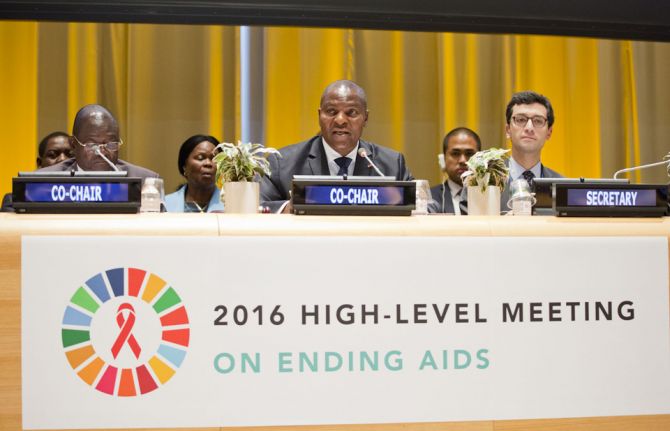
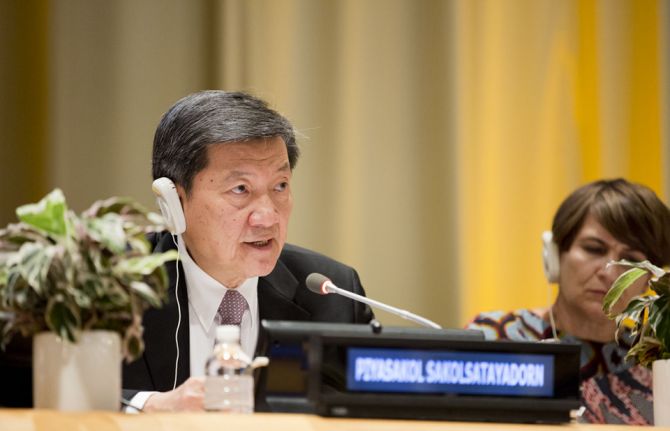
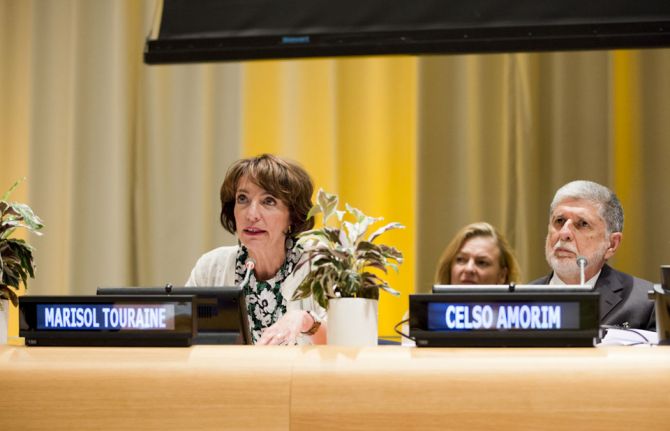
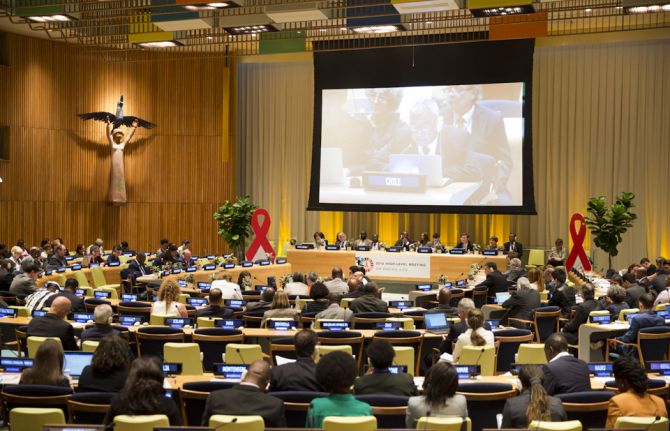
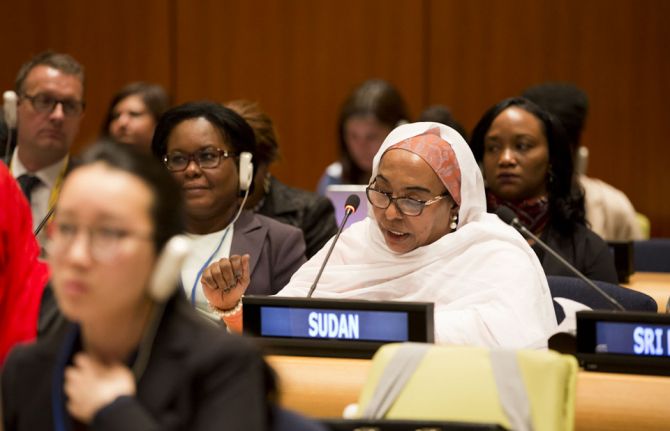
Update
Leaving no one behind: ending stigma and discrimination through social justice and inclusive societies
09 June 2016
09 June 2016 09 June 2016The AIDS epidemic will not be ended without efforts to end discrimination, respond to exclusion and advance social justice, according to a panel meeting held on 9 June during the United Nations General Assembly High-Level Meeting on Ending AIDS, taking place in New York, United States of America, from 8 to 10 June.
The panel, entitled “Leaving no one behind: ending stigma and discrimination through social justice and inclusive societies,” stressed that upholding the values of inclusion and social justice is fundamental to creating societies that advance dignity and share the benefit of wealth and health for all. It called for seizing the unparalleled opportunity offered by the 2030 Agenda for Sustainable Development and the newly adopted Political Declaration on HIV and AIDS to realize the vision of ending AIDS as a public health threat by 2030 in a manner grounded in the principles of equality, inclusion and respect for the rule of law.
The panel highlighted the efforts of civil society in demanding protection against stigma and discrimination and calling for justice, dignity and access to health services for all. Yet, panellist and speakers recognized that across the world, women and girls, young people, migrants, sex workers, men who have sex with men, people who inject drugs, transgender people and prisoners continue to be left behind because of discriminatory and punitive laws, policies and practices. Participants also expressed concern about restrictive legal and policy environments that hinder the work of civil society organizations in supporting the HIV response.
The panel called for moving from recognition of these challenges to actions for addressing them. It noted that an epidemic such as AIDS can be transformed into a pathfinder for addressing structural inequalities and vulnerabilities provided that all stakeholders translate their commitments to leaving no one behind into concrete programmes and funding for human rights.
The panel concluded with an urgent call for action on the following: ending discrimination in health care, education and the workplace; addressing intellectual property regimes that prevent millions of people from accessing life-saving HIV, hepatitis and other treatments; removing punitive laws that block effective responses for people living with HIV and other key populations; investing in human rights programmes and efforts by civil society; and setting clear goals with targets and indicators on ending discrimination, repealing punitive laws and advancing social justice.
Quotes
"There will be no end of AIDS without addressing the laws, policies and practices that make women, young people, prisoners, sex workers, men who have sex with men and people who use drugs vulnerable to HIV and limit their access to health services. Now is the time to expand human rights programmes that work and have proved successful in addressing discrimination in different contexts. More broadly, there can be no achievement of the health targets in Sustainable Development Goal (SDG) 3 without commitment to SDGs 5, 10 and 16 and the vision of eliminating inequalities and building inclusive societies.”
“Decriminalization of drug use, same-sex relationships and sex work is a matter of urgency. Instead of criminalizing, we should promote protective laws, policies and practices. This will make ending the AIDS epidemic a lot easier!”
“Gender inequality remains the most pervasive form of inequality around the world. Women and girls face extraordinary, and often intersecting, forms of discrimination. This is especially true for women living with HIV, migrants and refugee women, adolescent girls, women who use drugs or are sex workers, and lesbian, bisexual and transgender women and men. This is why in our work we must always aim to reach the last woman.”
Related

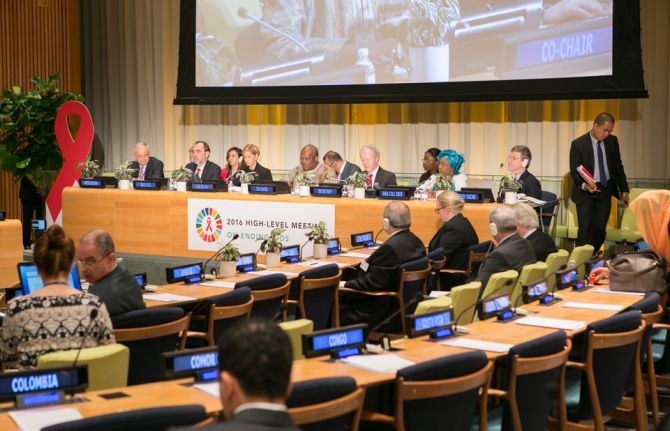

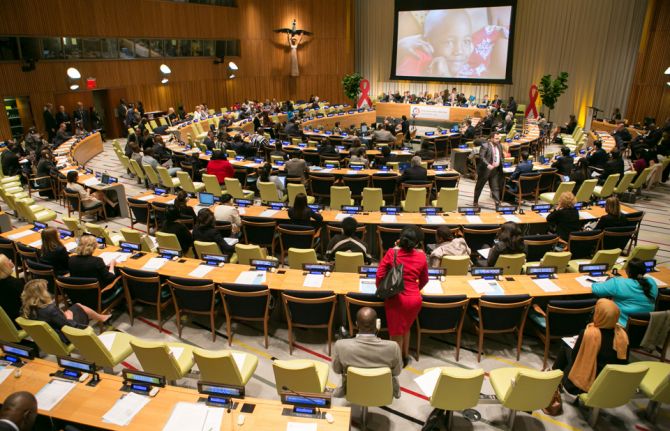
Update
Financing the end of AIDS: the window of opportunity
09 June 2016
09 June 2016 09 June 2016A panel meeting at the United Nations General Assembly High-Level Meeting on Ending AIDS, being held from 8 to 10 June, warned that the global commitment to end AIDS as a public health threat by 2030 cannot be met without increased funding, more efficiency and improved programme effectiveness.
Members of the panel, which met on 8 June and was entitled “Financing the end of AIDS: the window of opportunity,” argued that greater investment in the AIDS response needs to be front-loaded in the next five years and reach the US$ 26.2 billion needed by 2020 in low- and middle-income countries. Governments and development partners must increase their investments to close the nearly US$ 7 billion gap between the resources available for HIV in 2014 and the 2020 peak. This will avoid a looming funding crisis for treatment and prevention.
According to the gathering’s political leaders, experts and representatives of international organizations and civil society, this extra funding will allow the world to meet the 2020 interim targets on the road to ending the epidemic. These targets include the 90–90–90 treatment target of 90% of people living with HIV knowing their status, 90% of people who know their HIV-positive status accessing treatment and 90% of people on treatment having a suppressed viral load, reducing new HIV infections to fewer than 500 000 and elimination of HIV-related discrimination.
It was argued that the AIDS response must spend increased funding wisely by adopting the Fast-Track approach of rapidly scaling up treatment and prevention services with more efficient and effective programmes. The panel also discussed mechanisms to facilitate development partners and low- and middle-income countries front-loading resources to reach the ultimate goal of ending the AIDS epidemic as a public health threat by 2030.
Beyond the call for more funding and better allocation of existing resources, other critical factors for the sustainability of the response were highlighted, including local production of antiretroviral medicines in Africa, improvement in the procurement of commodities through price negotiations and access and affordability of modern pharmaceuticals in all countries.
There was a strong call for the following: facilitating the transition of countries moving into higher-income brackets, including supporting community-based programmes; fully funding the needs of gay men and other men who have sex with men, people who inject drugs, sex workers, transgender people and prisoners, and particularly young people among those populations; investing in communities; and scaling up public–private partnerships.
The panel stressed forcefully that the cost of inaction for individuals, communities, countries and regions was simply too high and that the world could not afford to miss this window of opportunity to make funding sustainable and reinvigorate the HIV response over the next five years.
Quotes
“Countries which can pay should do so in order for the international community to support other countries which have the will but not the financial means.”
“We need to guarantee full funding for prevention, treatment and care for people who inject drugs, gay men and other men who have sex with men, sex workers, transgender people and prisoners.” ,
“If we really want to take up the challenge of ending AIDS by 2030, we need to focus on innovative financing. Innovation financing since 2002 has yielded US$ 8 billion, including airline taxes and coupons for vaccines. It will be even more important now if we are to reach the Sustainable Development Goals.”
“The Global Fund to Fight AIDS, Tuberculosis and Malaria is everyone in this room, government, the private sector, civil society. If we all come together in the partnership that the Global Fund represents, we can absolutely end HIV, tuberculosis and malaria for good.”
“It is not just where the money comes from, it’s where the money is spent. It needs to be spent for people living with HIV, for women and for key populations. It is our lives on the line.”
“People who inject drugs have been left furthest behind in the global response to HIV. We know the HIV epidemic among people who inject drugs is driven by stigma, discrimination and violence. The lack of political willingness for harm reduction can be observed all over the world. We can virtually end AIDS among people who inject drugs by simply redirecting money from the war on drugs to harm reduction.”
“Innovation is something that we put as a top criterion for how we can deliver. We are always looking for new ideas, and I think they can come from our dedicated civil society organizations.”
“We need to see this endeavour as an investment from one generation to another. For the 2030 goals, a multisectoral approach will not allow us to reach only one objective but also to reach others. Today, crises are global and therefore require a global response.”
“For us, strengthening the health system is critical. We have a very ambitious objective to screen and treat, but with weak health systems we will be unable to achieve our goals.”
“We have a tremendously important opportunity with the replenishment of the Global Fund to Fight AIDS, Tuberculosis and Malaria. We need to look at the needs, estimate budgets based on those needs and then mobilize the resources. Everything should be driven by the analytics.”

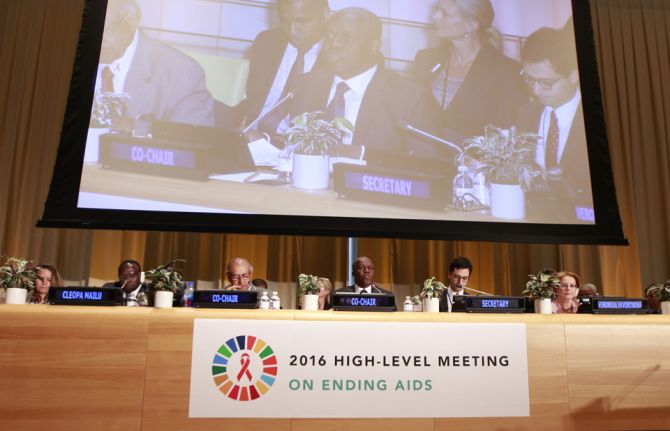
Update
AIDS and the sustainable development agenda: interdependent, inextricably linked
09 June 2016
09 June 2016 09 June 2016Efforts to end the AIDS epidemic and achieve the Sustainable Development Goals (SDGs) are closely linked and can lead to a wider, people-centred social transformation, argued a panel at the United Nations General Assembly High-Level Meeting on Ending AIDS, taking place in New York, United States of America, from 8 to 10 June. The panel meeting, entitled, “AIDS within the Sustainable Development Goals: leveraging the end of AIDS for social transformation and sustainable development,” was held on 8 June.
A number of participants noted that the lessons learned from the successes of the AIDS response at the national and global levels act as a pathfinder for the 2030 Agenda for Sustainable Development (Agenda 2030), adopted by United Nations Member States in 2015. This response has shown that working in a multisectoral way, with a range of partners and with an eye to challenging social, economic and gender inequalities using rights-based approaches, can lead to both health and development gains.
In setting out a Fast-Track approach to end AIDS, the UNAIDS 2016–2021 Strategy firmly acknowledges the need to root the HIV response in Agenda 2030, recognizing the interdependence between HIV and the SDGs, from ending poverty (SDG 1) to promoting inclusive societies (SDG 16) and strengthening partnerships (SDG 17).
During her remarks, the Russian Minister of Health, Veronika Skvortsova, committed to removing all remaining restrictions related to the travel, stay and entry of foreign citizens living with HIV in the Russian Federation.
The panel members set out concrete examples of how the AIDS response could help to influence the profound structural, social and economic changes needed to end AIDS and make the SDGs a reality: by promoting accountability, through grassroots alliances with communities acting as agents of change and by challenging inequality, stigma and marginalization and leaving no one behind.
The panel discussion generated a sense of urgency as well as momentum and opportunity to implement the Fast-Track approach in synergy and convergence with Agenda 2030, towards greater inclusion, social justice and stability across societies.
Quotes
“We must seize the opportunity of the Sustainable Development Goals (SDGs) to change the course of our planet and our humanity. The SDGs weave together environmental, social and economic well-being into a single, integrated global framework. They provide stepping stones to deepen and strengthen our efforts to end the AIDS epidemic.”
“I urge all of you to seize the opportunity to strengthen our efforts against AIDS by leveraging the synergies presented by the Sustainable Development Goals. Together, let us make the journey to end AIDS a journey of social transformation.”
“Today we have almost eliminated HIV transmission among people who use drugs through a comprehensive harm reduction programme. This was only possible through collaboration between health and police officers and through the inclusion of civil society.”
The Sustainable Development Goals provide a key opportunity to address the structural drivers that underlie the HIV epidemic. Ending AIDS is a feminist issue, giving young women and girls access to sexual health and rights education and services is integral to a sustainable HIV response.”
Related

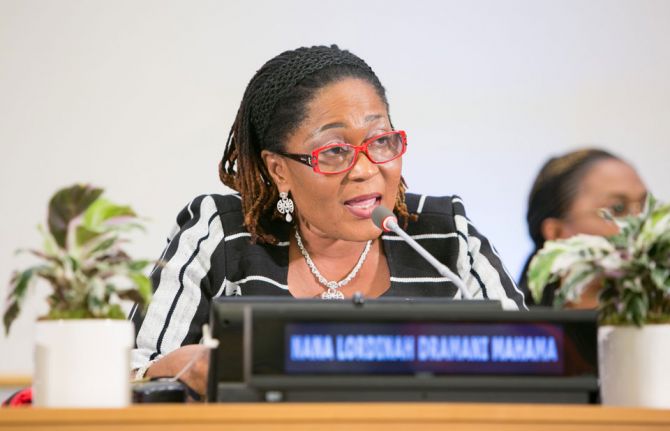
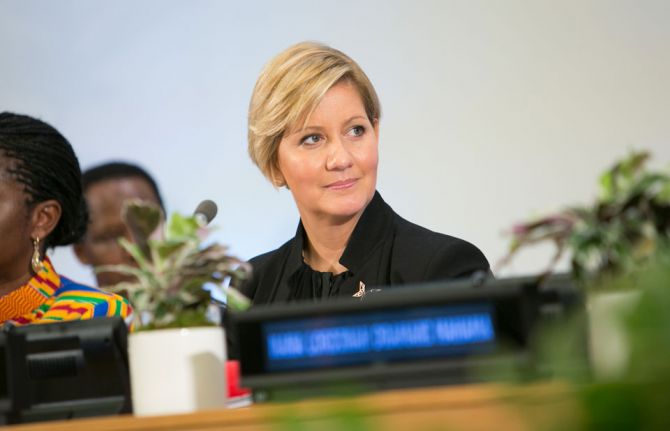





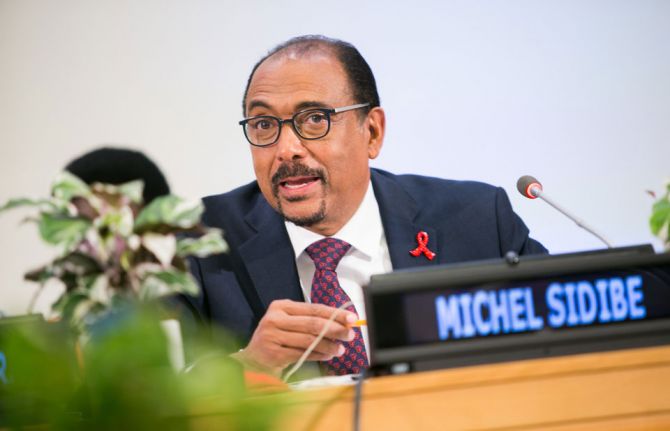
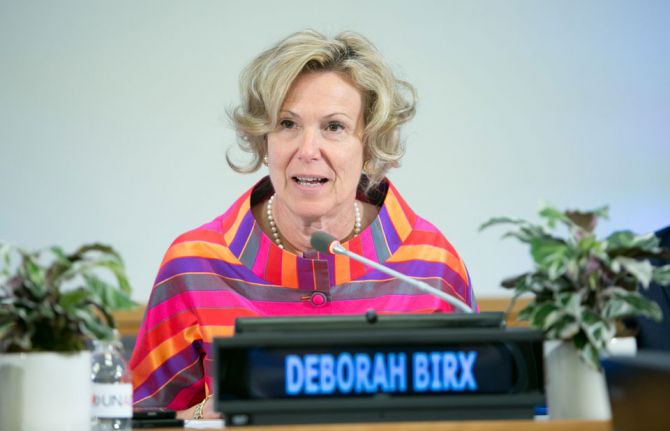
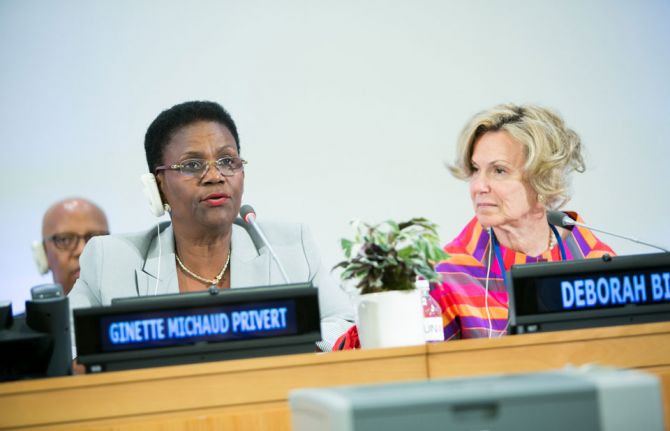
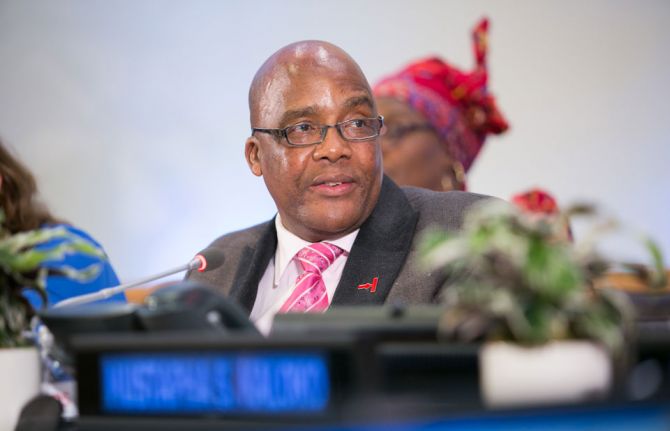
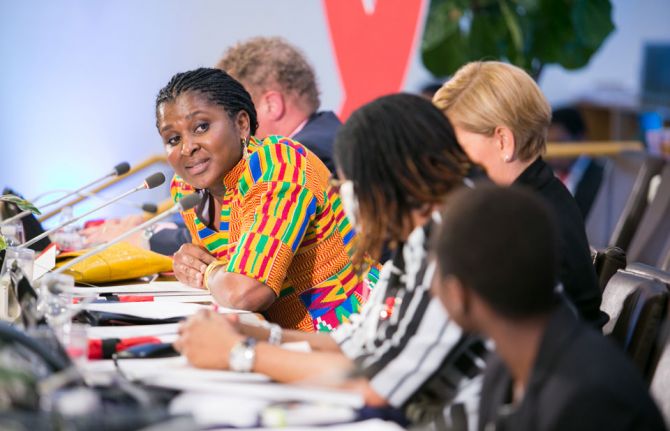
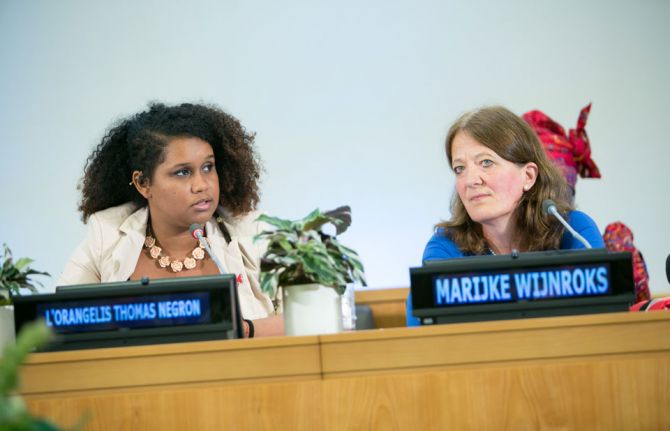
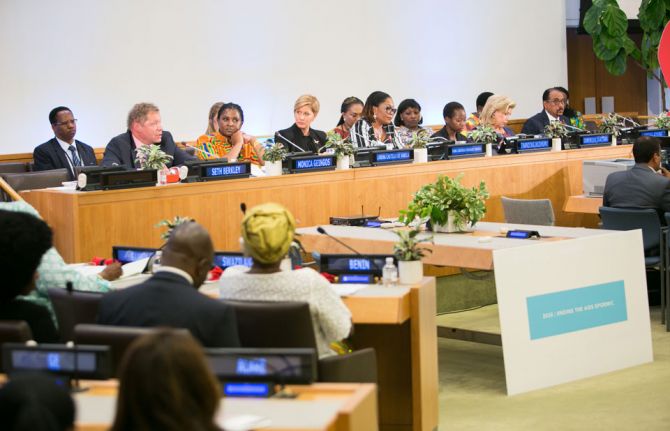
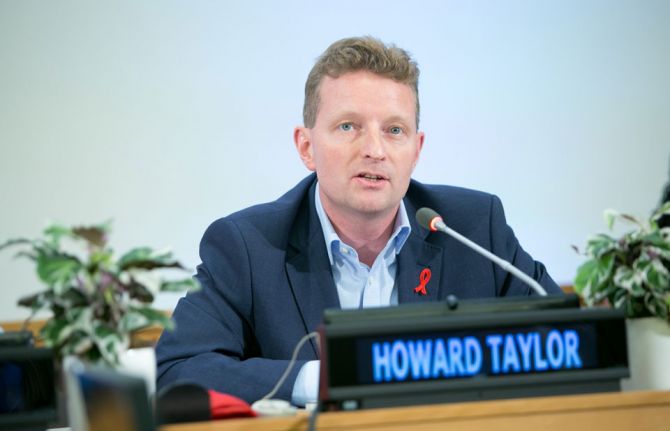

Press Release
Breaking the silos: empowering adolescent girls and young women to access integrated health-care services
09 June 2016 09 June 2016NEW YORK/GENEVA, 9 June 2016—At the United Nations General Assembly High-Level Meeting on Ending AIDS, taking place in New York, United States of America, the Organisation of African First Ladies against HIV/AIDS (OAFLA) has called for the stronger integration of services to improve health outcomes among adolescent girls and young women.
First Ladies from Africa were joined by the First Lady of Haiti and the First Lady of Panama in calling for the empowerment of young women and adolescent girls in the AIDS response. The First Ladies said adolescent girls must assume leadership roles to ensure the development of programmes and policies that are appropriate to their needs and fully respect their sexual and reproductive health and rights. They urged providers of health-care services to better integrate service delivery and programme design to support the ability of adolescent girls and young women to make informed life choices and keep themselves healthy, including by protecting themselves from HIV infection.
Globally, AIDS-related illnesses remain the leading cause of death among women of reproductive age. In 2015, there were an estimated 250 000 [180 000–340 000] new HIV infections worldwide among adolescents (aged 15–19 years), with adolescent girls accounting for 65% of new HIV infections among this age group. AIDS-related illnesses are estimated to be the leading cause of death among adolescents in sub-Saharan Africa. Gender-based violence, gender inequity, harmful gender norms, stigma and discrimination often prevent women and girls from knowing their HIV status and accessing appropriate HIV prevention and treatment services.
The OAFLA session showcased examples of ground-breaking adolescent-centred policies and programmes delivered by governments, adolescent girls and young women, international organizations, the private sector and international donors. The event at the High-Level Meeting on Ending AIDS was organized by OAFLA in collaboration with UNAIDS, Gavi, the Vaccine Alliance, and the United States President’s Emergency Plan for AIDS Relief.
Quotes from speakers
“The Organisation of African First Ladies against HIV/AIDS strongly believes that in moving towards the Fast Track Targets we must ensure that no young girl or boy is left behind. We must address the needs of young people, especially young girls, ending gender inequality and other factors that increase their vulnerability to HIV.” Lordina Mahama, First Lady of Ghana
“Information allows young people to make choices and empowerment is having a choice. I encourage us all to listen to best practice programmes so we can be catalysts and advocates for policies that really work for young women.” Lorena Castillo de Varela, First Lady of Panama
“Despite the progress achieved, we must redouble our efforts. We must offer in a simple way information in relation to HIV infection.” Claudine Talon, First Lady of Benin
“At a time when we are entering a new phase in the AIDS response we need to pay particular attention to women, young girls and infants. We need new strategies to stop violence against women and girls, reduce school drop-outs and end forced early marriage.” Adjoavi Sika Kabore, First Lady of Burkina Faso
“We have to offer communities a package of integrated approaches that include immunization, sexual and reproductive health and rights and education.” Antoinette Sassou-Nguesso, First Lady of the Congo
“We need to redouble our efforts to offer antiretroviral therapy to protect the future of our countries because our young people are the future. In particular, our young women need to have equal and fair access to education and health care.” Dominique Ouattara, First Lady of Côte d’Ivoire
“I would like to make a call for effective international solidarity that will allow Haiti to protect young women and adolescent girls.” Ginette Michaud Privert, First Lady of Haiti
“The issue is how we prevent new HIV infections among young women. We need comprehensive sexual education in our school curricula and we must speak to them in the language they understand … We have done so much, but there is much more to be done.” Monica Geingos, First Lady of Namibia
“It is extremely important to meet the reproductive health needs of young Africans in order to end the HIV epidemic within the framework of the Sustainable Development Goals.” Aissata Issoufou Mahamadou, First Lady of Niger
“We must push for comprehensive sexual and reproductive health and rights and ensure access for all young women and girls in all their diversity, including for key populations. We do not beg for our human rights, we demand them.” L’Orangelis Thomas Negron, HIV advocate
“We need to speak out and stop abuse and violence of any kind. I say enough!” Thandiwe Mudhumo, youth advocate
“Thandiwe Mudhumo is the embodiment of courage, resilience and hope. If we continue to fail adolescent girls and young women we will not end the AIDS epidemic.” Michel Sidibé, Executive Director of UNAIDS
“We need to value young girls, fix the issues that have resulted in the lack of impact in reducing HIV infections among them and develop determined, resilient, empowered, AIDS-free, mentored and safe young women who are ready to lead the next generation of girls.” Deborah Birx, United States Global AIDS Coordinator and Special Representative for Global Health Diplomacy
“Today’s generation of youth is the biggest in history. If we want a demographic dividend from that generation we have to invest in adolescents now. It depends on all of us breaking down silos and adopting innovative solutions.” Seth Berkley, Chief Executive Officer, Gavi, the Vaccine Alliance
UNAIDS
The Joint United Nations Programme on HIV/AIDS (UNAIDS) leads and inspires the world to achieve its shared vision of zero new HIV infections, zero discrimination and zero AIDS-related deaths. UNAIDS unites the efforts of 11 UN organizations—UNHCR, UNICEF, WFP, UNDP, UNFPA, UNODC, UN Women, ILO, UNESCO, WHO and the World Bank—and works closely with global and national partners towards ending the AIDS epidemic by 2030 as part of the Sustainable Development Goals. Learn more at unaids.org and connect with us on Facebook, Twitter, Instagram and YouTube.
Press centre
Download the printable version (PDF)

Press Release
Bold commitments to action made at the United Nations General Assembly High-Level Meeting on Ending AIDS
10 June 2016 10 June 2016The new Political Declaration adopted by United Nations Member States charts a course to end AIDS as a public health threat by 2030
UNITED NATIONS, NEW YORK, 10 June 2016—United Nations Member States have committed to implementing a bold agenda to end the AIDS epidemic by 2030 during the United Nations General Assembly High-Level Meeting on Ending AIDS, held in New York, United States of America, from 8 to 10 June. The progressive, new and actionable Political Declaration includes a set of specific, time-bound targets and actions that must be achieved by 2020 if the world is to get on the Fast-Track and end the AIDS epidemic by 2030 within the framework of the Sustainable Development Goals.
The High-Level Meeting on Ending AIDS was convened by the President of the General Assembly and co-facilitated by Switzerland and Zambia. At the opening, the President of the General Assembly, Mogens Lykketoft, urged Member States to commit to action.
“All stakeholders must now step up to the plate. Today is the day that we collectively say that we will end the AIDS epidemic by 2030,” said Mr Lykketoft. “We must pay greater attention to equality and inclusion, uphold human rights and speak out against stigma and discrimination.”
During the opening plenary, the United Nations Secretary-General, Ban Ki-moon, said that the AIDS response had been a “source of innovation and inspiration,” and the Executive Director of UNAIDS outlined the progress made in recent years, with 17 million people accessing antiretroviral treatment and significant declines in AIDS-related deaths and new HIV-infections among children.
"For the first time in history we can say that in Africa there are more people initiating HIV treatment than there are new HIV infections,” said UNAIDS Executive Director Michel Sidibé. He also underlined the importance of inclusion, saying, “The doors of the United Nations should be open to all.”
Among many of the civil society representatives who participated in and spoke at the meeting, Loyce Maturu, a young woman living with HIV from Zimbabwe, shared her inspiring story during the opening plenary about growing up living with HIV. "I want young people living with HIV to be able to realize their dreams and hopes for the future," she said.
Ndaba Mandela, a grandson of Nelson Mandela, spoke passionately about his own family’s experience of HIV and urged everyone present to stand together to end AIDS by 2030. “I'm here to ask you to continue the legacy of my grandfather, Nelson Mandela: a legacy of unity and leadership.”
In addition to the plenary sessions around 600 participants, including 10 Heads of State and Government and more than 60 ministers, people living with HIV, representatives of civil society, representatives of international organizations and the private sector, scientists and researchers took part in five official panels and more than 30 side events to translate the new Political Declaration into action and results.
The five official panels were under the following themes:
- AIDS within the Sustainable Development Goals: leveraging the end of AIDS for social transformation and sustainable development.
- Financing and sustaining the end of AIDS: the window of opportunity.
- Getting ahead of the looming treatment crisis: an action agenda for getting to 90–90–90.
- Leaving no one behind: ending stigma and discrimination through social justice and inclusive societies.
- Children, adolescent girls and young women: preventing new HIV infections.
Participants called for access to comprehensive sexuality education and harm reduction services as well as strengthening outreach to young women and adolescent girls and key populations, including men who have sex with men, sex workers, people who inject drugs, transgender people and prisoners as well as migrants.
During the High-Level Meeting on Ending AIDS, major announcements were made in support of ending the epidemic by 2030.
The United States of America announced the launch of a new US$ 100 million Key Populations Investment Fund to increase access to HIV services for sex workers, gay men and other men who have sex with men, people who inject drugs, transgender people and prisoners. The new fund will focus on reducing stigma and discrimination, empowering community leadership in the design and delivery of services and increasing the quality of data on key populations.
Yusuf K. Hamied, Chair of the Indian pharmaceutical company CIPLA, announced a package of assistance to African countries to facilitate the local production of medicines in Africa.
UNAIDS and the United States President’s Emergency Plan for AIDS Relief (PEPFAR) released a final report on the progress made since the Global Plan towards the elimination of new HIV infections among children by 2015 and keeping their mothers alive was launched at the last United Nations General Assembly High-Level Meeting on HIV and AIDS, in 2011.
There has been a 60% decline in new HIV infections among children since 2009 in the 21 countries in sub-Saharan Africa that have been most affected by the epidemic. To build on the enormous progress made in stopping new HIV infections among children, UNAIDS, PEPFAR and partners released a framework for ending AIDS among children, adolescents and young women—Start Free, Stay Free, AIDS-Free. The initiative sets ambitious targets to eliminate new infections among children, ensure access to treatment for all children living with HIV and prevent new HIV infections among adolescents and young women in order to put the world on a path to ending the AIDS epidemic among young women, adolescents and children.
Armenia, Belarus and Thailand joined Cuba in receiving official certificates of validation from the World Health Organization for eliminating new HIV infections among children. Thailand is the first country with a major HIV epidemic (450 000 people living with HIV in 2014) to receive such validation.
Events were held on the wider health agenda, including learning the lessons learned from responding to emerging epidemics, such as AIDS, Ebola and Zika, and on empowering adolescent girls and young women to access integrated health-care services, which was organized by the Organisation of African First Ladies against HIV/AIDS.
During the week of the meeting, several supporting events took place across New York. The Mayor of New York, Bill De Blasio, and the Mayor of Paris, Anne Hidalgo, convened around 30 mayors at the New York City Public Library to discuss how they are getting on the Fast-Track to end AIDS in cities. They also shared how smart cities are implementing urban innovations to achieve the Sustainable Development Goals.
In partnership with the Xinhua news agency, a billboard showcasing the UNAIDS Fast-Track response to ending AIDS ran in the city’s iconic Times Square. There was also an interfaith service and a number of events that focused on the importance of women’s involvement in leadership roles in the AIDS response.
On the eve of the High-Level Meeting on Ending AIDS, fashion designer and amfAR chair Kenneth Cole was named as an International Goodwill Ambassador for UNAIDS. UNAIDS International Goodwill Ambassador Annie Lennox took part in events throughout the week.
UNAIDS
The Joint United Nations Programme on HIV/AIDS (UNAIDS) leads and inspires the world to achieve its shared vision of zero new HIV infections, zero discrimination and zero AIDS-related deaths. UNAIDS unites the efforts of 11 UN organizations—UNHCR, UNICEF, WFP, UNDP, UNFPA, UNODC, UN Women, ILO, UNESCO, WHO and the World Bank—and works closely with global and national partners towards ending the AIDS epidemic by 2030 as part of the Sustainable Development Goals. Learn more at unaids.org and connect with us on Facebook, Twitter, Instagram and YouTube.
Press centre
Download the printable version (PDF)


